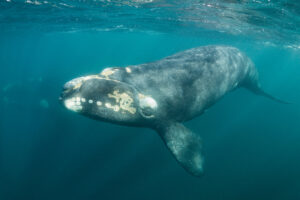
In February 2020, trolling motors from four major manufacturers entered a climate-controlled room at the Garmin facility in Olathe, Kan. The Minn Kota Ultrex, MotorGuide X5, Lowrance Ghost and Garmin Force were all on hand. They were bolted to a platform and positioned in a 21-foot tank a little more than 6 feet deep. Then a third-party research firm measured them for thrust.
The results were startling.
Garmin’s 36-volt Force, advertised at 100 pounds of thrust, tested at 113.5 pounds. The 36-volt Lowrance Ghost, advertised at 120 pounds of thrust, checked in at 74.9 pounds. MotorGuide’s 36-volt X5 is advertised at 105 pounds, but performed at 56.7 pounds. And the 36-volt Ultrex from Minn Kota, advertised at 112 pounds of maximum thrust, measured 72.2 pounds in the study.
Tank tests revealed that in some cases, lab results differed by more than 20 percent from the advertised thrust rating on product packaging. Similar results played out among the 24-volt variants available from some of the manufacturers.
According to Garmin, the lab test was set up as a measuring tool for continued development of the Force. “As we started developing our own trolling motor, one of the first things we wanted to do was to see what our competition was doing,” says Dave Dunn, Garmin Marine director of sales and marketing. “We wanted to test what they were doing to make our product better.
“I don’t disagree that a tank set is not a real-world, perfect condition,” Dunn adds. “But if anybody is doing a side-by-side comparison on the water, I believe our claims hold up.”

Budding Market
Currently, there is no universal requirement for how trolling motor manufacturers measure thrust. Some measure peak thrust, others measure sustained thrust, and test results can be manipulated to varying degrees using power supplies and propellers. None of that has been a major source of conflict until recently, because of the lack of diversity in the marketplace.
For decades, two brands — Minn Kota and MotorGuide — dominated the trolling motor industry. In recent years, Minn Kota built a sizable market share lead on its chief rival. In 2019, Lowrance and Garmin entered the fold, instantly doubling the number of major manufacturers in the marketplace. The result has been a wave of innovation that coincides with a battle for consumers’ attention. At ICAST, 2019 was dubbed “the year of the trolling motor” as two new brushless offerings from Garmin and Lowrance, alongside a redesigned MotorGuide Tour, stole the show.
Now each of those products is on store shelves, and each touts its own set of features and selling points, from cable steering to fly-by-wire to GPS locking and near-silent operation. With so many features, consumers are left with one universal measuring tool — thrust — to get a quick look at what a trolling motor might be capable of in the real world.
However, according to the Garmin-commissioned study by National Technical Systems, thrust ratings are all over the place. Soundings Trade Only sent copies of the report to each of the manufacturers listed to gauge their feedback on that very question.
“I think the report is good,” says Lowrance director of product development Lucas Steward. “The numbers are very similar to what we saw in our tank tests. These tests are good for being able to do a repeated trial or make sure you’re getting the same results over time, but they only tell a tiny story.”
Steward says he isn’t sure if the industry should use tank tests as a baseline for standardizing thrust ratings. “There’s a big component missing in tank tests versus the real world,” he says. “You need to have a dynamic situation on a boat to be able to evaluate a trolling motor’s performance. For example, when you get a prop like ours that gets good flow and is cutting and moving through the water, it picks up a ton of performance, and it keeps its efficiency. Tank tests are great, but if a user were to only buy off of a tank test, they might be very unhappy.”

MotorGuide says it understands the push to standardize measurements as trolling motor technology increases, but it defers to on-water results as the true measuring stick. “We’ve developed our internal tests to measure thrust at a sustained peak thrust over time, rather than an instant burst as performed in this study,” MotorGuide general manager Samuel Carlisle tells Soundings Trade Only. “We believe this type of measurement is more consistent with the way anglers operate in real-world conditions.” (Garmin says their test was a sustained peak thrust test, in contrast to Carlisle’s statement.)
Carlisle also says the X5 and propeller used in the lab test is a discontinued model, adding that the Michigan-based manufacturer would have preferred to run its new Tour Pro model instead.
Minn Kota parent company Johnson Outdoors did not respond to requests for comment.
On-Water Versus Tank Tests
Determining which trolling motor is the most capable for a consumer’s needs can require a dive into the Internet wormhole. YouTube battles pitting trolling motors against each other have racked up more than half a million views. Most are conducted by third-party channels with feature breakdowns and, sometimes, drag races. While these results are highly unscientific, they do demonstrate strong interest among anglers.
Manufacturers are running their own races, too. “We did races and sprints,” Steward says. “We did long-term races and GPS anchor tests. We did tests for accuracy and tests for quietness as we were spec’ing the product. We purposefully built what we built.”
Dunn says Garmin conducted its own races, but it’s difficult to put unscientific results on the side of a box. The scientific method seems to point back to the lab and to thrust.
“Think about this in automotive terms,” Dunn says. “If there is no standard, I can say that a car has 1,000 horsepower when it really only has 250 horsepower. There is no level playing field. But if there is a standard, nobody can make up their own, no matter what works best for their product packaging or marketing materials.”

Setting the Standard
The American Boat and Yacht Council, which develops global safety standards for design, construction, maintenance and repair of recreational boats, does not address trolling motor thrust ratings, according to ABYC technical vice president Craig Scholten. While some components of a trolling motor system are covered by the safety standards, the trolling motor itself is not.
“They are in a class by themselves,” he says. “Trolling motors are not a main propulsion engine and are not considered an outboard engine.”
According to Scholten, the ABYC has not seen a need to issue thrust rating standards for electric trolling motors, partially because of the limited scope of manufacturers in the field and primarily because the Coast Guard does not see thrust ratings below 115 pounds as a safety issue. “It’s more of a customer satisfaction issue versus a safety standard,” he says.
That leads us back to the crux of this issue: manufacturers disagree over whether or not customers benefit from a thrust rating standard. The industry’s oversight organization is concerned with safety issues and has not seen a demand or support for a standard.
Scholten does say that a thrust rating standard would help consumers with comparisons. “Electric propulsion is becoming more popular,” he says. “The weight of electric propulsion devices and their batteries is going to have a big influence on boat capacity, flotation and power ratings. I believe electric propulsion is eventually going to drive updates to the current standards.”
Should Trolling Motor Thrust Ratings Be Standardized?
Garmin: Yes. Garmin is advocating for a standardized process, overseen by a national organization, for regulating trolling motor thrust.
Lowrance: No. Lowrance says tank tests are not indicative of real-world performance.
MotorGuide: No. MotorGuide defers to on-water results.
Minn Kota: Johnson Outdoors did not respond to requests for comment.
This article was originally published in the May 2021 issue.











